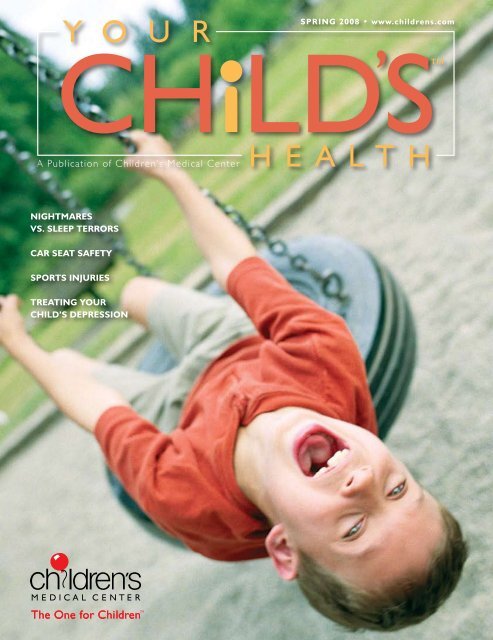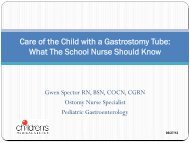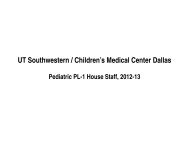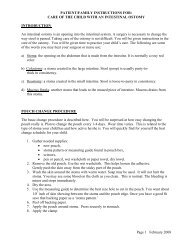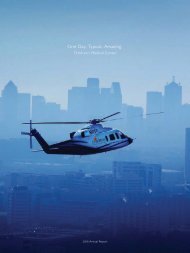NIGhtmAReS vS. SleeP teRRoRS cAR SeAt SAfety SPoRtS ...
NIGhtmAReS vS. SleeP teRRoRS cAR SeAt SAfety SPoRtS ...
NIGhtmAReS vS. SleeP teRRoRS cAR SeAt SAfety SPoRtS ...
Create successful ePaper yourself
Turn your PDF publications into a flip-book with our unique Google optimized e-Paper software.
<strong>NIGhtmAReS</strong><br />
<strong>vS</strong>. <strong>SleeP</strong> <strong>teRRoRS</strong><br />
<strong>cAR</strong> <strong>SeAt</strong> <strong>SAfety</strong><br />
<strong>SPoRtS</strong> INjuRIeS<br />
tReAtING youR<br />
chIlD’S DePReSSIoN<br />
SPRING 2008 • www.childrens.com
Sleep & Safety<br />
The chilDreN’S Sleep<br />
DiSorDerS ceNTer iS<br />
The oNly NaTioNally<br />
accreDiTeD proGraM<br />
iN NorTh TeXaS<br />
ThaT offerS peDiaTric<br />
paTieNTS coMpreheNSive<br />
DiaGNoSTic evaluaTioN<br />
aND full-Service<br />
TreaTMeNT.<br />
Things that Go Bump in the Night<br />
NightMares vs. sleep terrors – UNderstaNdiNg<br />
the differeNCe is Key to CalMiNg yoUr Child<br />
If you’ve awakened in the wee hours<br />
to the sound of your child’s frightened<br />
cry, you know how disconcerting nighttime<br />
fears can be for young children.<br />
Occasional nightmares, or scary dreams,<br />
are normal after 6 months of age.<br />
However, some children also have<br />
sleep terrors — very alarming sleep events<br />
that children rarely remember.<br />
“With sleep terrors, children appear to be<br />
in a state of profound fear and panic,” says<br />
Dr. Kamal Naqvi, medical director of the<br />
Children’s Sleep Disorders Center — the<br />
only North Texas pediatric sleep center<br />
accredited by the American Academy of<br />
Sleep Medicine. “Their eyes are open,<br />
they’re disoriented and inconsolable and<br />
their expression is one of total fear. It’s very<br />
compelling, even terrifying, for the adults<br />
who witness these events.”<br />
How to tell tHe Difference<br />
Nightmares:<br />
n Involve little body movement other than<br />
rapid eye movement (REM).<br />
n Usually happen in the second half of sleep.<br />
n Typically are caused by recent events or<br />
2<br />
Children’s Medical Center<br />
n<br />
n<br />
Kamal Naqvi, m.D.<br />
Medical Director, Sleep Disorders<br />
center, children’s Medical center<br />
a specific anxiety-producing situation.<br />
Are frequently recalled and involve detailed<br />
plots that often are related to the child’s<br />
experiences and developmental stage.<br />
Make return to sleep difficult for the child.<br />
Sleep Terrors:<br />
n Involve screaming, being fearful, kicking,<br />
sleepwalking and sleep talking.<br />
n Happen at fairly predictable times during<br />
the first half of sleep.<br />
n Often are related to a lack of sleep.<br />
n May be associated with a single frightening<br />
image, but the whole event rarely is<br />
remembered by the child.<br />
n Are usually outgrown with age.<br />
n Allow the child to return to sleep more<br />
easily, compared with nightmares.<br />
ways to Help<br />
When a child experiences sleep terrors, parents<br />
should gently get the child back into bed<br />
and not mention the episode in the morning.<br />
“Asking a lot of questions and telling the<br />
child all about it doesn’t help,” says Dr. Naqvi,<br />
also an assistant professor of Pediatrics at<br />
UT Southwestern Medical Center. “It can be<br />
very disconcerting to a child to be told he did<br />
things he has no recollection of.”<br />
Eliminating sleep terrors can be as simple<br />
as making sure your child gets more sleep.<br />
Developing and maintaining bedtime routines<br />
seven days a week is helpful. If the timing of<br />
the episodes is predictable, parents can gently<br />
wake the child 15 minutes beforehand and<br />
reassure him or her that everything is fine.<br />
seeking expert care<br />
If you think your child is experiencing sleep<br />
problems, ask your pediatrician if a sleep<br />
study is needed. The Sleep Disorders Center<br />
at Children’s Dallas and the dedicated center<br />
at the Children’s Legacy Ambulatory Care<br />
Pavilion in Plano offer inpatient and outpatient<br />
sleep studies to evaluate children for a variety<br />
of disorders and sleeping problems. n
Be Driven to car Seat Safety<br />
proper iNstallatioN redUCes risK of iNjUry<br />
it’s bad enough when 98 percent of all<br />
child car seats are used the wrong way.<br />
It’s worse when 100 percent of all<br />
parents think they’re using them<br />
correctly. Motor vehicle injuries continue<br />
to be the greatest risk to a child’s health.<br />
As a parent, you need to do more<br />
than just buckle up your child. It also<br />
matters how you buckle up your children<br />
and where they sit in the vehicle.<br />
DiD you know?<br />
n Texas law says all kids younger than<br />
15 must be buckled up.<br />
n Traffic accidents are the leading<br />
cause of death for children in the<br />
Dallas area.<br />
n The safest place in the car for a child<br />
is the back seat.<br />
n A car seat with a five-point harness<br />
offers the best protection.<br />
infants — rear facing<br />
Infants should always be placed in a<br />
rear-facing car seat in the back seat of a<br />
vehicle. Never place an infant in a rearfacing<br />
car seat in front of an air bag.<br />
If a baby is riding facing forward<br />
during a crash, the infant’s soft spinal<br />
column can stretch and the cord can be<br />
damaged. The baby could die or be paralyzed<br />
— even babies with strong neck<br />
muscles and good head control.<br />
Infants should face the back of the car<br />
as long as possible, until they are at least<br />
1 year old and weigh at least 20 pounds<br />
(preferably 30 pounds). If your baby<br />
weighs more than 20 pounds before<br />
age 1, a convertible car seat, certified<br />
to face the rear and hold up to 30<br />
pounds, should be used.<br />
toDDlers — forwarD facing<br />
Children older than 1 year and between<br />
20 and 30 pounds can use convertible<br />
car seats in the rear-facing position,<br />
but children between 30 and 40 pounds<br />
should be in a forward-facing car seat.<br />
The straps should be snug, and the top<br />
of the retainer clip should be positioned<br />
at the child’s armpit level to keep the<br />
harness straps in the correct position.<br />
The best place for a toddler’s car seat<br />
is the back seat of the vehicle.<br />
cHilDren — Booster seats<br />
Children are ready for a high-back<br />
booster seat when they weigh 40<br />
pounds, and they should remain in the<br />
seat until they are about 80 pounds.<br />
Booster seats raise the child up to<br />
a position at which the seat belt fits<br />
properly — low over the hips and snug<br />
over the shoulders and chest.<br />
Never use just a lap belt across a child<br />
sitting in a booster seat. Do not use<br />
pillows, books or towels to boost a child. n<br />
Go to www.childrens.com for an interactive guide<br />
on how to properly install your child’s car seat and<br />
information on free car seat checks.<br />
3<br />
www.childrens.com<br />
StAte’S oNly<br />
PeDIAtRIc hoSPItAl<br />
wIth A level I<br />
tRAumA ceNteR<br />
Whether they’ve fallen off a<br />
bike or been in a car accident,<br />
thousands of children and<br />
their families each year rely on<br />
the pediatric trauma experts<br />
at Children’s Medical Center<br />
Dallas.<br />
In February, the American<br />
College of Surgeons and the<br />
Texas Department of State<br />
Health Services renewed the<br />
hospital’s Level I trauma<br />
designation.<br />
Children’s became the first<br />
freestanding pediatric hospital<br />
in the Southwest to qualify<br />
for Level I trauma status in<br />
2005. To maintain this status,<br />
trauma services must be<br />
reverified every three years.<br />
To receive Level I trauma<br />
status a hospital must provide:<br />
n 24-hour coverage by trauma<br />
surgeons, pediatric emergency<br />
medicine specialists,<br />
anesthesiologists and operating<br />
room staff.<br />
n Prompt availability of<br />
care in specialties such as<br />
orthopedic surgery and<br />
neurosurgery.<br />
n Immediate availability of<br />
the trauma intensive care<br />
unit and critical care<br />
physicians.<br />
n Comprehensive radiology,<br />
including interventional<br />
radiology.<br />
n 24-hour availability of the<br />
laboratory and blood bank.<br />
n Substance abuse and<br />
alcohol screening.<br />
Children’s is one of only<br />
14 pediatric facilities in the<br />
country with Level I status.<br />
It also is one of the largest and<br />
busiest. In 2007, the hospital<br />
saw more than 13,000 trauma<br />
cases.
Injury preventIon<br />
To learN More<br />
aBouT SporTS iNjury<br />
preveNTioN, viSiT The<br />
chilDreN’S WeB SiTe<br />
www.chIlDReNS.com.<br />
Mix it up<br />
Severe injuries are on the rise in<br />
young athletes, and studies have<br />
shown that a year-round focus<br />
on a single sport may be partly<br />
to blame.<br />
“Intense, full-time efforts in<br />
one sport can lead to a lot of overuse injuries<br />
in children,” says Dr. Philip Wilson,<br />
an orthopedic specialist at Children’s Medical<br />
Center and assistant professor of orthopedic<br />
surgery at UT Southwestern Medical Center.<br />
“We never used to see this damage until they<br />
were in late high school or even college.”<br />
Young athletes are still growing. That means<br />
they face a higher risk for harm than adults.<br />
4<br />
Children’s Medical Center<br />
Philip wilson, m.D.<br />
orthopedic Specialist,<br />
children’s Medical center<br />
foCUsiNg oN oNe sport CaN lead to overUse iNjUries<br />
Research shared at the 2007 meeting of the<br />
American Academy of Orthopaedic Surgeons<br />
found that sports injuries are responsible<br />
for two of five emergency room visits<br />
by children ages 5 to 14.<br />
otHer finDings:<br />
n Some students, not yet in high school, are<br />
hurting their shoulders so badly they need<br />
surgery once reserved for older athletes.<br />
n Injuries to the anterior cruciate ligament<br />
(ACL) are now seen in younger children.<br />
The ACL links the upper and lower leg<br />
bones at the front of the knee.<br />
n Arm injuries are on the rise in young<br />
pitchers. Experts blame poor throwing<br />
motion.<br />
wHy is year-rounD play at fault?<br />
“We’re not seeing the selective stress distributed<br />
about their body like we used to see in<br />
childhood athletes, where they played baseball<br />
for fun one month and the next month,<br />
basketball, and next season, football,”<br />
Dr. Wilson says.<br />
Experts say players, parents and coaches<br />
must heed the needs of growing bodies. Training<br />
should match the child’s stage of growth.<br />
“Stress should be placed in different areas of<br />
the child’s body, allowing time for recovery,”<br />
Dr. Wilson says. “There is widespread overtraining<br />
of children.”<br />
Strength training in 12-year-olds works<br />
against the child’s natural development.<br />
That is an age for working on coordination<br />
and speed, which are best improved by a<br />
variety of activities rather than one specialized<br />
activity. n
Sports injury prevention and<br />
first aid resources at the<br />
click of a Button<br />
if your child injured an ankle while<br />
playing soccer or sustained a head<br />
injury on the football field, would<br />
you or your child’s coach know how to<br />
respond?<br />
Children’s supports North Texas<br />
families and coaches with injury prevention<br />
workshops and a comprehensive<br />
online health library on the Children’s<br />
Web site, www.childrens.com.<br />
The Children’s Web site provides<br />
detailed information and easy-tounderstand<br />
medical illustrations for<br />
numerous sports injury prevention<br />
and first aid topics, including:<br />
n Normal heart and breathing rates.<br />
n Spine injuries.<br />
n Bleeding injuries.<br />
n Tooth loss.<br />
n Eye lacerations.<br />
n Moving an injured athlete.<br />
In addition, orthopedic surgeons<br />
and emergency medicine specialists at<br />
Children’s are among the experts<br />
featured on the hospital’s speaker’s<br />
bureau. This group is focused on prevention<br />
and evaluation of sports-related<br />
injuries and other health topics of<br />
interest to coaches, parents and student<br />
athletes.<br />
Since 2003, nearly 45,000 coaches<br />
have attended workshops hosted by<br />
specialists on the Children’s medical staff.<br />
Topics range from evaluating muscle<br />
sprains and strains to preventing<br />
dehydration. n<br />
A handy injury assessment reference<br />
chart that can easily be attached to<br />
clipboards or placed in sports-equipment<br />
bags is available on the hospital’s web site<br />
www.childrens.com/Patients_families.<br />
5<br />
www.childrens.com<br />
SKIN INfectIoNS<br />
moRe commoN<br />
AmoNG AthleteS<br />
Staphylococcus aureus,<br />
commonly known as staph,<br />
is becoming more and more<br />
common among athletes who<br />
participate in contact sports<br />
such as football and wrestling.<br />
Most staph infections can be<br />
treated easily, but some staph<br />
infections lead to more serious<br />
illness.<br />
Infections known as methicillin-resistant<br />
Staphylococcus<br />
aureus, or MRSA, are resistant<br />
to certain antibiotics, making<br />
them harder to treat.<br />
Good hygiene and proper<br />
treatment and covering of cuts<br />
and scrapes are essential to<br />
preventing the spread of the<br />
bacteria that causes staph.<br />
The national Centers for<br />
Disease Control & Prevention<br />
provides the following tips on<br />
preventing the spread of staph:<br />
n Keep cuts and scrapes clean<br />
and covered with a bandage<br />
or don’t participate in practice<br />
or competitions until<br />
skin infections heal or can<br />
be covered adequately. Don’t<br />
touch cuts or bandages on<br />
another person.<br />
n Practice good hygiene. Wash<br />
your hands frequently or<br />
use an alcohol-based hand<br />
sanitizer and shower with<br />
soap, hot water and clean<br />
towels after all practices<br />
and competitions.<br />
n Don’t share towels, clothing<br />
or personal items such as<br />
razors.<br />
n Clean equipment regularly.<br />
n Learn first aid for wounds<br />
and how to recognize<br />
potential skin infections.<br />
n Tell your coach or athletic<br />
trainer if you think you<br />
have a skin infection.<br />
Coaches and athletic trainers<br />
should regularly check<br />
athletes for skin lesions.
HealtH & Safety<br />
DepreSSioN TreaTMeNT<br />
opTioNS for chilDreN<br />
May raNGe froM<br />
SupporTive TreaTMeNT<br />
To Specific TherapieS<br />
or aNTiDepreSSaNTS.<br />
Treating Depression in children<br />
A<br />
recent study reported that<br />
youth suicide rates in the<br />
United States and the<br />
Netherlands increased after<br />
a decline in the number<br />
of prescriptions written<br />
for antidepressants. This report and other<br />
depression-related information in the news<br />
may have parents confused about treatment<br />
options for their child.<br />
While there is no one answer to treating<br />
depression in children, individualized assessment<br />
and care can lead to effective results.<br />
When a child is showing signs of depression<br />
and/or suicidal thinking, an assessment by a<br />
6<br />
Children’s Medical Center<br />
qualified primary care physician or mental<br />
health professional should be a family’s first<br />
concern, says Dr. Graham Emslie, chief of<br />
psychiatry at Children’s Medical Center and<br />
chief of Child and Adolescent Psychiatry at<br />
UT Southwestern Medical Center.<br />
Following a professional assessment and<br />
correct diagnosis of depression, the recommended<br />
treatment options for the child may<br />
range from supportive treatment to specific<br />
therapies or antidepressants.<br />
The choice to use antidepressant medications<br />
to treat children and adolescents will<br />
then be an individual decision based on a<br />
collaborative discussion among the healthcare<br />
professional, family and patient.<br />
proper assessment<br />
“The risk of not treating your child for depression<br />
is great,” Dr. Emslie says. “If there is<br />
a risk from these medications, it would be<br />
small. Adequate assessment and monitoring<br />
of their medication and mood is crucial.”<br />
Dr. Emslie pioneered the treatment of<br />
depressed children and adolescents with the<br />
drug fluoxetine — the only drug approved by<br />
the FDA for that use — although physicians<br />
may prescribe other antidepressants in children<br />
and adolescents.<br />
The use of antidepressants should be<br />
closely monitored since a child’s depressive<br />
symptoms can worsen even with medication.<br />
However, the most recent medical literature<br />
finds that the benefits of using antidepressants<br />
appear to be much greater than the risks from<br />
suicidal thinking and self-harming behaviors.<br />
There are no simple formulas for the treatment<br />
of depression, Dr. Emslie says. “But with<br />
proper assessment and treatment, children<br />
with depression can be helped.” n<br />
To learn more about the pediatric psychiatry department or to schedule an appointment,<br />
call 214-456-5900 or go to www.childrens.com.<br />
model used for illustrative purposes only.<br />
Graham emslie, Ph.D.<br />
chief of psychiatry,<br />
children’s Medical center<br />
aNtidepressaNts CaN Be effeCtive, BUt iNdividUalized<br />
Care is Needed for yoUNg patieNts
elyse tyler<br />
registered Dietitian,<br />
children’s Medical center<br />
Get Kids Moving to Burn calories<br />
and feel Better<br />
things have changed since your<br />
childhood — recess and gym are<br />
no longer a given in some schools.<br />
Kids are more likely to spend their free<br />
time playing video games than playing<br />
outdoors.<br />
“Parents would be surprised to know<br />
how little physical exercise their kids<br />
are actually getting each day,” says<br />
Elyse Tyler, a registered dietitian and<br />
program manager for the Dean Foods<br />
LEAN (Lifestyle Exercise and Nutrition)<br />
Families program at Children’s. “It’s<br />
much less than kids were getting 30<br />
years ago.”<br />
Government guidelines say children<br />
ages 2 to 19 should get at least 60 minutes<br />
of moderate to vigorous physical activity<br />
a day. Staying fit helps kids maintain a<br />
healthy weight. That’s vital since one in<br />
three U.S. children is overweight or obese.<br />
Activity also builds kids’ self-esteem.<br />
Any activity is great, but what burns<br />
the most calories? Find your child’s weight<br />
on the chart below to get an estimate of<br />
the calories he or she burns by participating<br />
in the activities listed. n<br />
the hospital’s Dean foods leAN<br />
families program provides comprehensive<br />
weight-management therapy for children<br />
and their families. to learn more about<br />
this program, go to www.childrens.com/<br />
services/leanfamilies.<br />
cAloRIeS BuRNeD IN AN houR At A chIlD’S weIGht<br />
Activity 50 lbs. 70 lbs.<br />
child’s weight<br />
90 lbs. 110 lbs. 130 lbs.<br />
Aerobic dancing 152 213 274 335 396<br />
Backpacking 164 230 295 361 426<br />
Bicycling (stationary) 164 230 295 361 426<br />
Bicycling (outdoor) 187 262 337 412 487<br />
Bowling 70 98 127 155 183<br />
Dancing 105 148 190 232 274<br />
Jogging (5 mph) 187 262 337 412 487<br />
Jumping rope 234 328 422 515 609<br />
Racquetball 164 230 295 361 426<br />
Running (8 mph) 316 443 569 696 822<br />
Skating (ice- or roller-) 164 230 295 361 426<br />
Swimming 141 197 253 309 365<br />
Tennis 164 230 295 361 426<br />
Volleyball 70 98 127 155 183<br />
Walking (2 mph) 59 82 105 129 152<br />
Source: Mayo Foundation for Medical Education and Research. These figures are approximate.<br />
The exact rate depends on a child’s gender, height and stage of puberty.<br />
7<br />
www.childrens.com<br />
tIPS foR heAlthy<br />
ShoPPING<br />
Involving children in food<br />
choices and grocery shopping<br />
is a creative way to help them<br />
improve eating habits, teach<br />
them about nutrition and expose<br />
them to new foods. These<br />
tips can help:<br />
eat Before you sHop<br />
Hunger while shopping is a<br />
sure-fire recipe for ending up<br />
with impulse items in your<br />
cart – at any age. Consider<br />
shopping after breakfast or<br />
in the morning, when kids’<br />
tummies are full and they are<br />
well-rested. Also, allow children<br />
to munch on a healthy snack<br />
while food shopping to help<br />
curb the desire to put sugary or<br />
high-fat snacks into the cart.<br />
recruit little Helpers<br />
Letting the kids help can speed<br />
up the shopping trip and they<br />
will appreciate the freedom.<br />
Keeping them busy and focused<br />
on their shopping tasks also<br />
helps them forget to beg for<br />
junk food. Let them have a<br />
voice in choosing their own<br />
cereal, after-school snacks and<br />
drinks. Teach cost comparison<br />
skills by making them give you<br />
an update on their choices and<br />
why it was the best deal.<br />
teacH tHe aBcs of proDuce<br />
Teaching your children to<br />
navigate the produce section<br />
significantly contributes to the<br />
development of healthy eating<br />
habits. Let your children pick<br />
a food they have never tried<br />
before and help you prepare it<br />
at home.
1935 Motor St.<br />
Dallas, TX 75235<br />
Nonprofit<br />
U.S. Postage<br />
PAID<br />
Children’s<br />
Medical Center<br />
Your community now has the one<br />
outpatient care facility with<br />
the most pediatric specialists.<br />
The Children’s Legacy Ambulatory Care Pavilion now offers the largest suburban<br />
group of pediatric specialists in the nation. Which means all your child’s outpatient<br />
needs, from ENT and urology to orthopedics and cardiology, can now be handled in one<br />
close and convenient location by specialists from UT Southwestern Medical Center. You’ll<br />
also have access to imaging and laboratory services. For a full list of available services<br />
and more information about this new state-of-the-art facility, visit childrens.com.<br />
Articles in this newsletter are written by professional<br />
journalists or physicians who strive to present reliable,<br />
up-to-date information. But no publication can replace the<br />
care and advice of medical professionals, and readers are<br />
cautioned to seek such help for personal problems. All models<br />
used for illustrative purposes only. (SP08) 6208M<br />
The physicians who treat patients at Children’s Medical Center Dallas<br />
are not employees or agents of Children’s. They are either (i) independent<br />
physicians engaged in the private practice of medicine who have staff<br />
privileges at Children’s; (ii) independent physicians who are independent<br />
contractors and have staff privileges at Children’s; (iii) physicians who are<br />
employed by The University of Texas Southwestern Medical Center<br />
at Dallas or another institution who have staff privileges at Children’s;<br />
or (iv) physicians participating in the care of patients as part of a postgraduate<br />
medical education program.<br />
Children’s Legacy<br />
Ambulatory Care Pavilion<br />
7906 Preston Rd., Plano, TX 75024<br />
childrens.com or 972-730-KIDS


